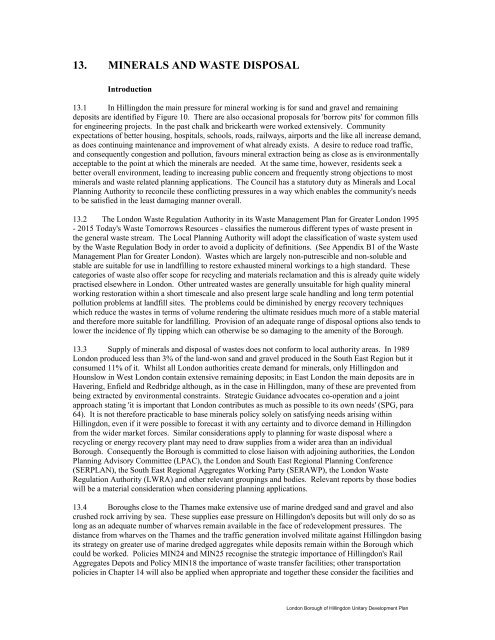HILLINGDON UNITARY DEVELOPMENT PLAN - London Borough ...
HILLINGDON UNITARY DEVELOPMENT PLAN - London Borough ...
HILLINGDON UNITARY DEVELOPMENT PLAN - London Borough ...
You also want an ePaper? Increase the reach of your titles
YUMPU automatically turns print PDFs into web optimized ePapers that Google loves.
13. MINERALS AND WASTE DISPOSAL<br />
Introduction<br />
13.1 In Hillingdon the main pressure for mineral working is for sand and gravel and remaining<br />
deposits are identified by Figure 10. There are also occasional proposals for 'borrow pits' for common fills<br />
for engineering projects. In the past chalk and brickearth were worked extensively. Community<br />
expectations of better housing, hospitals, schools, roads, railways, airports and the like all increase demand,<br />
as does continuing maintenance and improvement of what already exists. A desire to reduce road traffic,<br />
and consequently congestion and pollution, favours mineral extraction being as close as is environmentally<br />
acceptable to the point at which the minerals are needed. At the same time, however, residents seek a<br />
better overall environment, leading to increasing public concern and frequently strong objections to most<br />
minerals and waste related planning applications. The Council has a statutory duty as Minerals and Local<br />
Planning Authority to reconcile these conflicting pressures in a way which enables the community's needs<br />
to be satisfied in the least damaging manner overall.<br />
13.2 The <strong>London</strong> Waste Regulation Authority in its Waste Management Plan for Greater <strong>London</strong> 1995<br />
- 2015 Today's Waste Tomorrows Resources - classifies the numerous different types of waste present in<br />
the general waste stream. The Local Planning Authority will adopt the classification of waste system used<br />
by the Waste Regulation Body in order to avoid a duplicity of definitions. (See Appendix B1 of the Waste<br />
Management Plan for Greater <strong>London</strong>). Wastes which are largely non-putrescible and non-soluble and<br />
stable are suitable for use in landfilling to restore exhausted mineral workings to a high standard. These<br />
categories of waste also offer scope for recycling and materials reclamation and this is already quite widely<br />
practised elsewhere in <strong>London</strong>. Other untreated wastes are generally unsuitable for high quality mineral<br />
working restoration within a short timescale and also present large scale handling and long term potential<br />
pollution problems at landfill sites. The problems could be diminished by energy recovery techniques<br />
which reduce the wastes in terms of volume rendering the ultimate residues much more of a stable material<br />
and therefore more suitable for landfilling. Provision of an adequate range of disposal options also tends to<br />
lower the incidence of fly tipping which can otherwise be so damaging to the amenity of the <strong>Borough</strong>.<br />
13.3 Supply of minerals and disposal of wastes does not conform to local authority areas. In 1989<br />
<strong>London</strong> produced less than 3% of the land-won sand and gravel produced in the South East Region but it<br />
consumed 11% of it. Whilst all <strong>London</strong> authorities create demand for minerals, only Hillingdon and<br />
Hounslow in West <strong>London</strong> contain extensive remaining deposits; in East <strong>London</strong> the main deposits are in<br />
Havering, Enfield and Redbridge although, as in the case in Hillingdon, many of these are prevented from<br />
being extracted by environmental constraints. Strategic Guidance advocates co-operation and a joint<br />
approach stating 'it is important that <strong>London</strong> contributes as much as possible to its own needs' (SPG, para<br />
64). It is not therefore practicable to base minerals policy solely on satisfying needs arising within<br />
Hillingdon, even if it were possible to forecast it with any certainty and to divorce demand in Hillingdon<br />
from the wider market forces. Similar considerations apply to planning for waste disposal where a<br />
recycling or energy recovery plant may need to draw supplies from a wider area than an individual<br />
<strong>Borough</strong>. Consequently the <strong>Borough</strong> is committed to close liaison with adjoining authorities, the <strong>London</strong><br />
Planning Advisory Committee (LPAC), the <strong>London</strong> and South East Regional Planning Conference<br />
(SER<strong>PLAN</strong>), the South East Regional Aggregates Working Party (SERAWP), the <strong>London</strong> Waste<br />
Regulation Authority (LWRA) and other relevant groupings and bodies. Relevant reports by those bodies<br />
will be a material consideration when considering planning applications.<br />
13.4 <strong>Borough</strong>s close to the Thames make extensive use of marine dredged sand and gravel and also<br />
crushed rock arriving by sea. These supplies ease pressure on Hillingdon's deposits but will only do so as<br />
long as an adequate number of wharves remain available in the face of redevelopment pressures. The<br />
distance from wharves on the Thames and the traffic generation involved militate against Hillingdon basing<br />
its strategy on greater use of marine dredged aggregates while deposits remain within the <strong>Borough</strong> which<br />
could be worked. Policies MIN24 and MIN25 recognise the strategic importance of Hillingdon's Rail<br />
Aggregates Depots and Policy MIN18 the importance of waste transfer facilities; other transportation<br />
policies in Chapter 14 will also be applied when appropriate and together these consider the facilities and<br />
<strong>London</strong> <strong>Borough</strong> of Hillingdon Unitary Development Plan
















